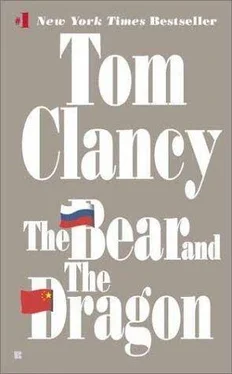Tom Clancy - The Bear and the Dragon
Здесь есть возможность читать онлайн «Tom Clancy - The Bear and the Dragon» весь текст электронной книги совершенно бесплатно (целиком полную версию без сокращений). В некоторых случаях можно слушать аудио, скачать через торрент в формате fb2 и присутствует краткое содержание. Год выпуска: 2001, ISBN: 2001, Жанр: Триллер, на английском языке. Описание произведения, (предисловие) а так же отзывы посетителей доступны на портале библиотеки ЛибКат.
- Название:The Bear and the Dragon
- Автор:
- Жанр:
- Год:2001
- ISBN:780425180969
- Рейтинг книги:3 / 5. Голосов: 1
-
Избранное:Добавить в избранное
- Отзывы:
-
Ваша оценка:
- 60
- 1
- 2
- 3
- 4
- 5
The Bear and the Dragon: краткое содержание, описание и аннотация
Предлагаем к чтению аннотацию, описание, краткое содержание или предисловие (зависит от того, что написал сам автор книги «The Bear and the Dragon»). Если вы не нашли необходимую информацию о книге — напишите в комментариях, мы постараемся отыскать её.
The Bear and the Dragon — читать онлайн бесплатно полную книгу (весь текст) целиком
Ниже представлен текст книги, разбитый по страницам. Система сохранения места последней прочитанной страницы, позволяет с удобством читать онлайн бесплатно книгу «The Bear and the Dragon», без необходимости каждый раз заново искать на чём Вы остановились. Поставьте закладку, и сможете в любой момент перейти на страницу, на которой закончили чтение.
Интервал:
Закладка:
Anti-missile work had been relegated to theater missiles, such as the ubiquitous Scuds, which the Russians doubtless regretted ever having built, much less sold to jerkwater countries that couldn’t even field a single decent mechanized division, but who loved to parade those upgraded V-2-class ballistic stovepipes because they looked impressive as hell to the people on the sidewalks. But the new upgrades on Patriot and its Russian counterpart SAM largely negated that threat, and the Navy’s Aegis system had been tested against them, with pretty good success. Like Patriot, though, Standard was really a point-defense weapon with damned little cross-range ability to cover an area instead of maybe twenty square miles of important sea-estate.
All in all, it was a pity that they’d never solved the power-throughput problem with his free-electron lasers. Those could have defended whole coastlines, if only … and if only his aunt had balls, Gregory thought, she’d be his uncle. There was talk of building a chemical laser aboard a converted 747 that could sure as hell clobber a ballistic launch during boost phase, but to do that, the 747 had to be fairly close to the launch point, and so that was just one more version of theater defense, and of little strategic use.
The Aegis system had real possibilities. The SPY radar system was first-rate, and though the computer that managed the information was the flower of 1975 technology-a current Apple Macintosh had it beat by a good three orders of magnitude in all categories of performance-intercepting a ballistic warhead wasn’t a question of computing speed so much as kinetic energy-getting the kill vehicle to the right place at the right time. Even that wasn’t so great a feat of engineering. The real work had been done as far back as 1959, with the Nike Zeus, which had turned into Spartan and shown great promise before being shitcanned by the 1972 treaty with the Soviet Union, which was, belatedly, just as dead as the Safeguard system, which had been aborted at half-built. Well, the fact of the matter was that MIRV technology had negated that entire defense concept. No, you had to kill the ICBM in boost phase to kill all the MIRVs at once, and do it over the enemy’s territory so that if he had a primitive arming system he’d only fry his own turf. The method for doing that was the Brilliant Pebbles system developed at Lawrence-Livermore National Laboratory, and though it had never been given a full-up test, the technology was actually pretty straightforward. Being hit by a matchstick traveling at fifteen thousand miles per hour would ruin your entire day. But that would never happen. The drive to fund and deploy such a system had died with all the ballistic launchers. In a way, it was a pity, Gregory thought. Such a system would have been a really cool engineering accomplishment-but it had little practical application today. The PRC retained its land-based ballistic launchers, but there were only ten or so of them, and that was a long way from the fifteen hundred the Soviets had once pointed at America. The Chinese had a missile submarine, too, but Gregory figured that CINCPAC could make that go away if he had to. Even if it was just tied alongside the pier, one two-thousand-pound smart bomb could take it out of play, and the Navy had a lot of those.
So, he thought, figure the PRC gets really pissed at Taiwan, and figure the Navy has an Aegis cruiser tied alongside so that its sailors can get drunk and laid in the city, and those folks in Beijing pick that moment to push the button on one of their ICBMs, how can the Navy keep its cruiser from turning into slag, and oh, by the way, keep the city of Taipei alive …?
The SM-2-ER had almost enough of the right ingredients to handle such a threat. If the missile was targeted on where the cruiser was, cross-range was not an issue. You just had to put the interceptor on the same line of bearing, because in essence the inbound rack wasn’t moving at all, and you just had to put the SAM in the same place-Spot X-that the RV was going to be, at Time Y. The Aegis computer could figure where and when that was, and you weren’t really hitting a bullet with a bullet. The RV would be about a meter across, and the kill-zone of the SAM’s warhead would be about, what? Three meters across? Five? Maybe even eight or ten?
Call it eight, Al Gregory thought. Was the SM-2 that accurate? In absolute terms, probably yes. It had ample-sized control surfaces, and getting into the line of a jet aircraft-what the SM-2 had been designed to kill-had to take into account the maneuverability of the aircraft (pilots would do their damnedest to avoid the things), and so the eight-meter globe of destruction could probably be made to intercept the inbound RV in terms of pure geometry.
The issue was speed. Gregory popped open another Diet Coke from the room’s minibar and sat back on the bed to consider how troublesome that issue was. The inbound RV, at a hundred thousand feet, would be traveling at about sixteen thousand miles per hour, 23,466 feet per second, eight times the speed of a rifle bullet, 7,150 meters per second. That was pretty damned fast. It was about the same speed as a high-explosive detonation. You could have the RV sitting next to a ton of TNT at the moment the explosive went off, and the explosion couldn’t catch up with the RV. That was FAST.
So, the SAM’s warhead has to go off well before it gets to where the RV is. Figuring out how much was a simple mathematical exercise. That meant that the proximity fuse on the SM-2 was the important variable in the equation, Gregory decided. He didn’t know that he was wrong on this, didn’t see what he was missing, and went on with his calculations. The software fix for the proximity laser fusing system looked less difficult than he’d imagined. Well, wasn’t that good news?
It was another early day for Minister Fang Gan. He’d gotten a phone call at his home the previous night, and decided he had to arrive early for the appointment made then. This was a surprise for his staff, who were just setting up for the day when he breezed in, not looking as cross as he felt for the disturbance of his adamantine routine. It wasn’t their fault, after all, and they had the good sense not to trouble him, and thus generate artificial wrath.
Ming was just printing up her downloads from the Web. She had pieces that she thought would be of interest, especially one from The Wall Street Journal, and another from Financial Times. Both commented on what she thought might be the reason for the minister’s early arrival. His 9:20 appointment was with Ren He-Ping, an industrialist friendly with her boss. Ren arrived early. The slender, elderly man looked unhappy-no, she thought, worried-about something. She lifted her phone to get permission, then stood and walked him into the inner office, racing back outside to fetch morning tea, which she hadn’t had a chance to serve her boss yet.
Ming was back inside in less than five minutes, with the fine porcelain cups on a decorated serving tray. She presented the morning drinks to both men with an elegance that earned her a thank-you from her boss, and then she took her leave. Ren, she saw, wasn’t any happier to be in with her minister.
“What is the problem, Ren?”
“In two weeks, I will have a thousand workers with nothing to do, Fang.”
“Oh? What is the reason for that, my friend?”
“I do much business with an American business. It is called Butterfly. They sell clothing to wealthy American women. My factory outside Shanghai makes the cloth, and my tailoring plant at Yancheng turns the fabric into clothing, which we ship to America and Europe. We’ve been doing business with Butterfly for three years now, very satisfactorily for all concerned.”
Читать дальшеИнтервал:
Закладка:
Похожие книги на «The Bear and the Dragon»
Представляем Вашему вниманию похожие книги на «The Bear and the Dragon» списком для выбора. Мы отобрали схожую по названию и смыслу литературу в надежде предоставить читателям больше вариантов отыскать новые, интересные, ещё непрочитанные произведения.
Обсуждение, отзывы о книге «The Bear and the Dragon» и просто собственные мнения читателей. Оставьте ваши комментарии, напишите, что Вы думаете о произведении, его смысле или главных героях. Укажите что конкретно понравилось, а что нет, и почему Вы так считаете.






![Александр Ирвин - Tom Clancy’s The Division 2. Фальшивый рассвет [litres]](/books/417744/aleksandr-irvin-tom-clancy-s-the-division-2-falsh-thumb.webp)




